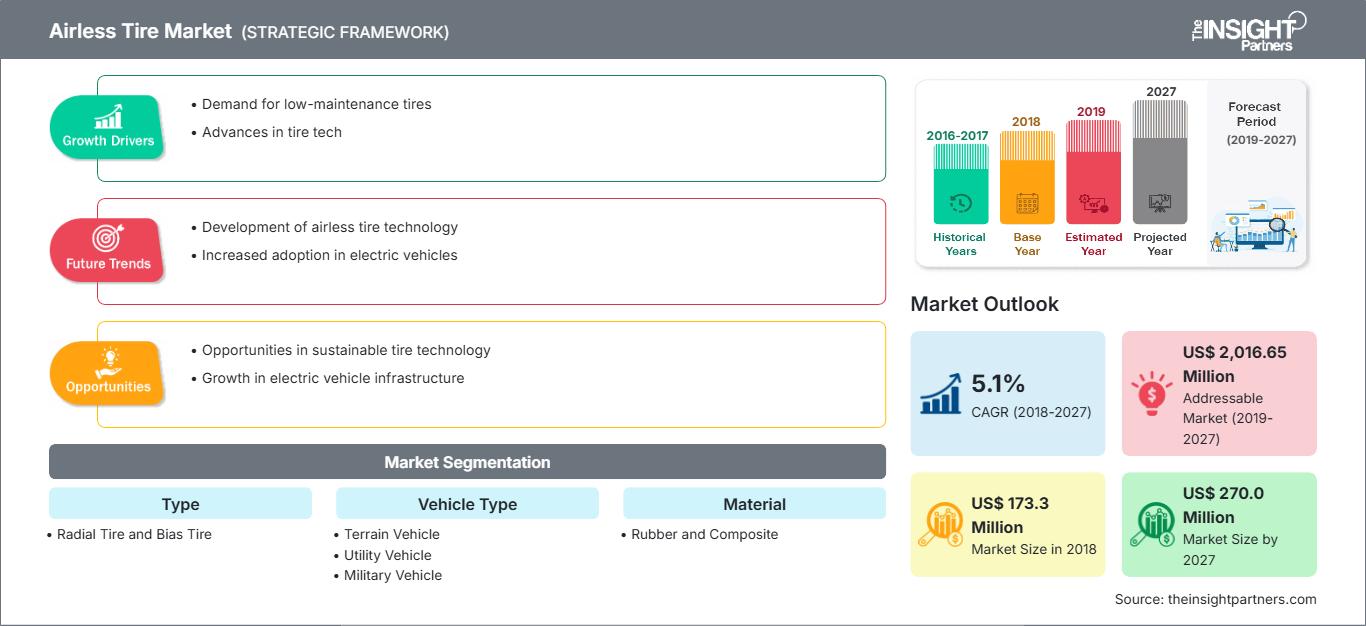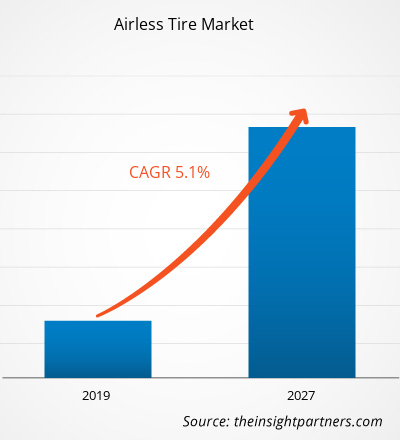Il mercato degli pneumatici airless è ampiamente segmentato in cinque regioni principali: Nord America, Europa, APAC, MEA e SAM. La regione più importante nel mercato globale degli pneumatici airless è rappresentata dal Nord America, seguita da Asia-Pacifico ed Europa. Il predominio del Nord America nel mercato degli pneumatici airless è dovuto al fatto che la regione ospita diversi produttori di pneumatici airless, che capitalizzano in modo significativo sulla ricerca e sviluppo del prodotto. Gli Stati Uniti sono il mercato più grande del Nord America, nonché il mercato globale degli pneumatici airless, e si prevede che domineranno il mercato per tutto il periodo di previsione dal 2019 al 2027. Il mercato globale degli pneumatici airless è destinato a crescere durante il periodo di previsione. L'adozione degli pneumatici airless in diverse aree geografiche è in costante crescita tra diverse tipologie di veicoli. I vantaggi offerti dagli pneumatici airless hanno influenzato diversi settori, tra cui edilizia, agricoltura, commercio, estrazione mineraria e militare. Il mercato degli pneumatici airless è in una fase iniziale e diverse aziende consolidate, così come operatori più piccoli, operano sul mercato globale.
Personalizza questo rapporto in base alle tue esigenze
Potrai personalizzare gratuitamente qualsiasi rapporto, comprese parti di questo rapporto, o analisi a livello di paese, pacchetto dati Excel, oltre a usufruire di grandi offerte e sconti per start-up e università
Mercato dei pneumatici senza aria: Approfondimenti strategici

-
Ottieni le principali tendenze chiave del mercato di questo rapporto.Questo campione GRATUITO includerà l'analisi dei dati, che vanno dalle tendenze di mercato alle stime e alle previsioni.
A livello globale, la tendenza all'urbanizzazione sta crescendo a un tasso esponenziale. Di conseguenza, anche il reddito medio disponibile della popolazione che vive nelle città urbane sta aumentando. La produzione di veicoli ha registrato una crescita costante nel periodo post-recessione a partire dal 2010. Un settore chiave è il settore dei veicoli pesanti e dei veicoli commerciali, caratterizzato da un elevato livello di innovazione e sviluppi legati alla sicurezza stradale. L'aumento del parco veicoli ha comportato un aumento degli incidenti, causato da vari fattori, come la pressione inadeguata degli pneumatici. Le attrezzature pesanti dotate di pneumatici airless sono in grado di trasportare più peso e di svolgere attività più impegnative rispetto agli pneumatici tradizionali.
Approfondimenti sul segmento di tipologia
In base alla tipologia, il segmento degli pneumatici radiali ha dominato il mercato globale degli pneumatici airless nel 2018. In uno pneumatico radiale, la disposizione delle tele è a 90 gradi rispetto alla direzione di marcia, ovvero rispetto al centro dello pneumatico (radialmente). Uno pneumatico radiale consente al battistrada e al fianco di funzionare come due elementi indipendenti dello pneumatico del veicolo.
Approfondimenti sul segmento di materiale
In base al materiale, il segmento della gomma ha dominato il mercato globale degli pneumatici airless. Uno pneumatico convenzionale è realizzato in gomma incapsulata in aria compressa. Gli pneumatici stanno dominando il mercato globale degli pneumatici.
Approfondimenti sul segmento di mercato per tipologia di veicolo
In base alla tipologia di veicolo, il segmento dei veicoli utilitari ha detenuto la quota maggiore del mercato globale degli pneumatici airless nel 2018. I veicoli utilitari includono diverse tipologie di veicoli utilizzati per numerose applicazioni industriali. Questi veicoli sono progettati e realizzati per svolgere compiti specifici in modo più efficace ed efficiente rispetto ai veicoli per il trasporto di passeggeri.
Gli operatori del mercato si concentrano su innovazioni e sviluppi di nuovi prodotti integrando tecnologie e funzionalità avanzate nei loro prodotti per competere con i concorrenti.
- Nel 2019, Michelin Tweel Technologies, una divisione di Michelin North America, Inc., ha introdotto un nuovo pneumatico radiale airless da 26 pollici con un mozzo a quattro bulloni, progettato per UTV (veicoli utilitari o veicoli da lavoro).
- Nel 2018, Michelin ha avviato una partnership con General Motors per testare e collaudare il prototipo Uptis che equipaggerà le auto dal 2024.
- Nel 2017, Toyo Tires ha annunciato lo sviluppo di "noair", un pneumatico concept airless neo-futuristico che non richiede alcun riempimento d'aria.
Il mercato globale degli pneumatici airless è stato segmentato come segue: Mercato degli pneumatici airless - Per tipo
- Pneumatico radiale
- Pneumatico diagonale
Mercato dei pneumatici senza aria - Per materiale
- Gomma
- Composito
Mercato dei pneumatici senza aria - Per tipo di veicolo
- Veicoli fuoristrada
- Veicoli utilitari
- Veicoli militari
Mercato degli pneumatici airless: per regione
- Nord America
- Stati Uniti
- Canada
- Messico
- Europa
- Francia
- Germania
- Italia
- Regno Unito
- Russia
- Resto d'Europa
- Asia Pacifico (APAC)
- Cina
- India
- Sud Corea
- Giappone
- Australia
- Resto dell'APAC
- Medio Oriente e Africa (MEA)
- Sudafrica
- Arabia Saudita
- Emirati Arabi Uniti
- Resto dell' MEA
- Sud America (SAM)
- Brasile
- Argentina
- Resto del SAM
Approfondimenti regionali sul mercato degli pneumatici senza aria
Le tendenze regionali e i fattori che influenzano il mercato degli pneumatici senza aria durante il periodo di previsione sono stati ampiamente spiegati dagli analisti di The Insight Partners. Questa sezione analizza anche i segmenti e la geografia del mercato degli pneumatici senza aria in Nord America, Europa, Asia-Pacifico, Medio Oriente e Africa, America Meridionale e Centrale.
Ambito del rapporto sul mercato degli pneumatici senza aria
| Attributo del rapporto | Dettagli |
|---|---|
| Dimensioni del mercato in 2018 | US$ 173.3 Million |
| Dimensioni del mercato per 2027 | US$ 270.0 Million |
| CAGR globale (2018 - 2027) | 5.1% |
| Dati storici | 2016-2017 |
| Periodo di previsione | 2019-2027 |
| Segmenti coperti |
By Tipo
|
| Regioni e paesi coperti |
Nord America
|
| Leader di mercato e profili aziendali chiave |
|
Densità degli operatori del mercato degli pneumatici senza aria: comprendere il suo impatto sulle dinamiche aziendali
Il mercato degli pneumatici senza aria è in rapida crescita, trainato dalla crescente domanda degli utenti finali, dovuta a fattori quali l'evoluzione delle preferenze dei consumatori, i progressi tecnologici e una maggiore consapevolezza dei vantaggi del prodotto. Con l'aumento della domanda, le aziende stanno ampliando la propria offerta, innovando per soddisfare le esigenze dei consumatori e sfruttando le tendenze emergenti, alimentando ulteriormente la crescita del mercato.

- Ottieni il Mercato dei pneumatici senza aria Panoramica dei principali attori chiave
- Amerity
- Bridgestone Corporation
- Continental
- Evolution Wheel
- Hankook Tire & Technology Co. Ltd.
- McLaren Industries
- Michelin
- Sumitomo Rubber Industries Ltd.
- The Goodyear Tire & Rubber Company
- Toyo Tire & Rubber Co. Ltd.
- Analisi storica (2 anni), anno base, previsione (7 anni) con CAGR
- Analisi PEST e SWOT
- Valore/volume delle dimensioni del mercato - Globale, Regionale, Nazionale
- Industria e panorama competitivo
- Set di dati Excel
Report recenti
Rapporti correlati
Testimonianze
Motivo dell'acquisto
- Processo decisionale informato
- Comprensione delle dinamiche di mercato
- Analisi competitiva
- Analisi dei clienti
- Previsioni di mercato
- Mitigazione del rischio
- Pianificazione strategica
- Giustificazione degli investimenti
- Identificazione dei mercati emergenti
- Miglioramento delle strategie di marketing
- Aumento dell'efficienza operativa
- Allineamento alle tendenze normative






















 Ottieni un campione gratuito per - Mercato dei pneumatici senza aria
Ottieni un campione gratuito per - Mercato dei pneumatici senza aria